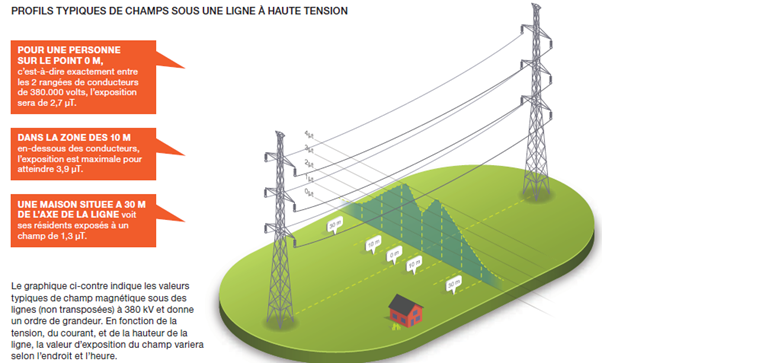Electric and magnetic fields
Electricity transmission generates very-low-frequency electric and magnetic fields (50 hertz).
Electric and magnetic fields
An electric field is the force of attraction or repulsion exerted by one electric charge on another. A magnetic field is the force exerted by a moving electric charge. Electric and magnetic fields are present everywhere in our environment and on our planet, and have both a field strength and a frequency.
-
Scientific explanation
 When a light is connected to the power grid, there is always an electric field, even when the light switch is off and no power is being supplied to the light. The electric field varies with the voltage (V). The higher the voltage, the stronger the electric field. The electric field strength is expressed in volts per metre (V/m).
When a light is connected to the power grid, there is always an electric field, even when the light switch is off and no power is being supplied to the light. The electric field varies with the voltage (V). The higher the voltage, the stronger the electric field. The electric field strength is expressed in volts per metre (V/m).
Electric and magnetic fields occur naturally as static fields that are either constant or vary very slowly. One example is the earth's magnetic field, which generates currents that circulate in the earth's core. The earth's magnetic field is around 40 μT in our part of the world. Another example is the natural electric field on the earth's surface, which is usually around 100 V/m but can rise to 10 kV/m (i.e. 100 times greater) during storms. When the light is on and power is flowing through the wire, this generates a magnetic field as well as an electric field. The magnetic field varies with the current (A). The greater the current, the stronger the magnetic field generated. The unit for measuring magnetic fields is the ampere per metre (A/m) but we generally use the tesla (T), which is the unit for expressing magnetic flux density. The magnetic fields around high-voltage installations are expressed in microteslas (μT). A microtesla is one millionth of a tesla.
When the light is on and power is flowing through the wire, this generates a magnetic field as well as an electric field. The magnetic field varies with the current (A). The greater the current, the stronger the magnetic field generated. The unit for measuring magnetic fields is the ampere per metre (A/m) but we generally use the tesla (T), which is the unit for expressing magnetic flux density. The magnetic fields around high-voltage installations are expressed in microteslas (μT). A microtesla is one millionth of a tesla.
However, most fields are variable and are known as alternating fields. These fields have a frequency (speed of variation, expressed in hertz (Hz)) and a field strength. This is the case with fields generated by a high-voltage line, whose frequency is 50 Hz, as well as domestic electrical installations and all the equipment they supply. -
Electric and magnetic fields around overhead lines
The strength of an electric field along an overhead line depends on the voltage and distance from the line. A high voltage level (380 kV) generates a stronger electric field (on average 3-4 kV/m at 1.5 metres above the ground beneath the line) than lower voltage levels (220, 150 or 70-kV lines). The presence of buildings and vegetation considerably weakens the electric field. Inside a home, it is between 10 and 100 times weaker than outside.
The magnetic field generated by a high-voltage line depends directly on the current flowing through the line as well as the configuration of the conductors (one or two circuits, type of pylon) and the distance. The level of a magnetic field therefore varies more from one line to another than an electric field.
In any case, the magnetic field decreases sharply with distance from the line (see figure). Beyond a distance of 100 to 120 metres from a 380-kV overhead line, there are no emissions of magnetic fields. With a 150-kV line, the magnetic field virtually disappears at 30 to 40 metres, and with a 70-kV line the equivalent distance is 20 metres.
Typical field profiles beneath a high-voltage line (380kV)
For a person at the 0-M point, i.e. exactly mid-way between the two 380-kV conductors, the exposure is 2.7 µT.
The 10-M zone beneath the conductors has the highest exposure level, at 3.9 µT.
In a house located 30M from the line axis, residents are exposed to a field of 1.3 µT.
The figure opposite gives the approximate typical values for a magnetic field beneath (untransposed) 380-kV high-voltage lines. The field exposure value varies by location and time depending on the voltage, the current and the height of the line. -
Electric and magnetic fields around underground lines
Underground lines do not produce electric fields because the fields are blocked by the insulating cladding around the cable.
However, the cables do still produce magnetic fields, which are not blocked by being underground. Immediately above an underground line, the magnetic field is greater than that generated by an overhead line of the same amperage. The strongest field recorded at ground level just above an underground line may be double the strength of one beneath an overhead line, although it will tail off very quickly. Accordingly, the field barely registers at all at a distance of 10 metres from the line route (less than 0.1 µT).
-
Detecting electric fields near an overhead line
In some cases, you can directly or indirectly perceive an electric field nearby or underneath an overhead line.
Direct perception underneath or very close to an overhead line:
- People with a lower sensory threshold may in, some cases, experience a sensation of superficial tingling of the skin underneath a 380kV overhead line. This is caused by vibrations in the hair on the scalp and skin.
Indirect perception underneath or very close to an overhead line:
- Tingling or a slight shock if you touch a metal object. This is similar to electrostatic discharges in dry and cold weather. It can be a bit unpleasant, but is usually harmless and can be remedied by earthing metal objects.
- A crackling sound if the weather is damp (rain, fog or snow). This is known as the corona effect. The strong electrical field immediately around the electric wires generates small electrical discharges that ionise the surrounding air molecules. The effect is enhanced during light rain.
-
Detecting magnetic fields near an overhead lineThere are no longer any situations where we can perceive the effects of magnetic fields.
With early pacemakers, patients might experience unusual discomfort when exposed to strong magnetic fields, but this has been remedied by manufacturers, whose devices are now insensitive to magnetic fields from overhead lines in compliance with European legislation on the electromagnetic compatibility of electrical devices.
Very old computer screens could also be affected by magnetic fields, but thanks to technological developments, magnetic fields no longer affect image quality.
Possible health effects
The potential effects on human health of exposure to electromagnetic fields have been the subject of numerous studies over the past 30 or more years and are still open to question today. Elia therefore wishes to take a completely transparent approach to the issue and regularly seeks guidance from independent experts.
Since the 1970s, a great deal of research has been carried out into the possible health effects of very-low-frequency electromagnetic fields. In adults, scientists have been unable to establish any link with health effects. In children, epidemiological studies have found a statistical correlation between prolonged average daily exposure to field strengths of 0.4 μT and above and the risk of leukaemia. However, no causal link has so far been proved. To date, no other tangible health effects (Alzheimer's, hypersensitivity, etc.) caused by long-term exposure to low field strengths have been scientifically established, although research in this area is ongoing.
Elia believes it is important to support these studies and therefore backs initiatives such as the Belgian BioElectroMagnetics Group (BBEMG), which conducts research into the health effects of electric and magnetic fields. BBEMG researchers are required to abide by the Code of Ethics for Scientific Research in Belgium, and cooperation with Elia must not and will not affect this.
The BBEMG brings together independent experts from Wallonia and Flanders who study the health effects of electric and magnetic fields linked to the transmission and use of electrical energy at work and in our day-to-day lives.
Internationally, Elia supports the Electric Power Research Institute (EPRI), a non-profit organisation that conducts research on energy and the environment. Link toe te voegen
Legislation
In 1999, the European Union published a Recommendation on the limitation of exposure of the general public to electromagnetic fields. As recommended by the International Commission on Non-Ionizing Radiation Protection (ICNIRP) in 1998, it proposed a limit of 100 μT for public exposure.
After the International Agency for Research on Cancer (IARC) classified electromagnetic fields as possibly carcinogenic to humans in 2001, the scientific knowledge was reviewed, but no reason was found to revise the 1999 recommendations.
Belgium has no federal legislation on very-low-frequency magnetic fields. Consequently, the Council of the European Union's recommended maximum exposure limit of 100 μT serves as a benchmark. For electric fields, the Belgian General Regulations for Electrical Installations set maximum levels of between 5 kV/m (residential areas) and 10 kV/m.
Based on the sectoral conditions in the Walloon and Brussels-Capital Regions, the same 100-µT limit applies to the operation of power transformers.
In Brussels, there is a protocol concerning the installation of new high-voltage cables, which was approved by the Brussels government on 23 December 2016. The protocol requires new 150-kV cables to be a certain distance from homes.
Flanders has drawn up guidelines for the construction of new overhead lines, which require the number of existing homes located in the 0.4-µT corridor to be kept to a minimum.
0.4 µT is a guideline value taken from the decree on the indoor environment (Flemish Government Decree of 11 June 2004 on measures to combat health risks from pollution of the indoor environment). Guideline values indicate the level above which health risks may arise. They target risks from long-term (chronic) exposure and are mainly designed to raise awareness. The intervention value is 20 µT, which means that measures may be taken where this value is exceeded.
Measures taken by Elia
Elia observes the applicable standards in its projects and takes the necessary precautions. Magnetic fields are analysed for each project and measures implemented if necessary.
In addition to the maximum values under legal regulations, a guideline value of 0.4 μT is often applied. This is based on epidemiological studies that have found a statistical link with childhood leukaemia. Elia develops its projects in such a way as to fall within the lowest threshold for electromagnetic field emissions. This is a value that Elia strives to achieve, although the situation on the ground, technical requirements and general interest criteria sometimes override this.

